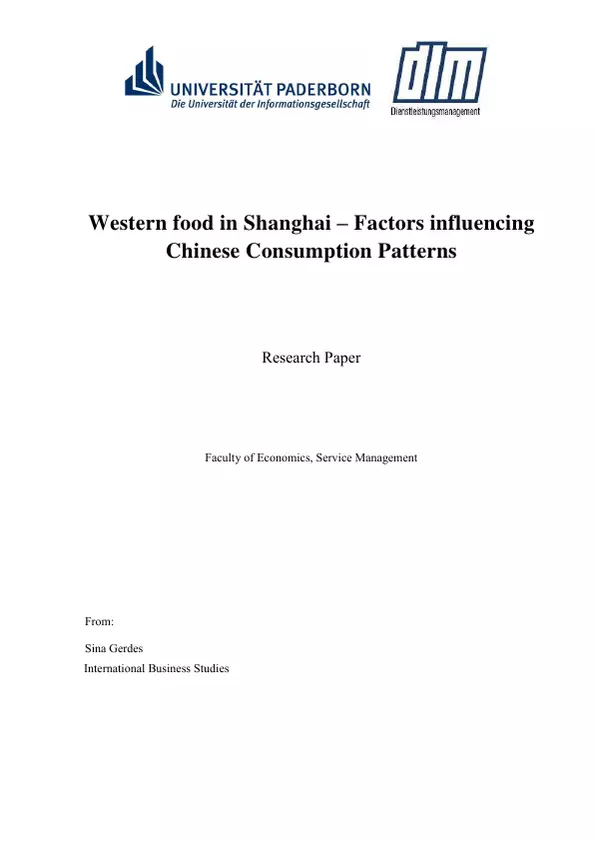Eating is a basic need for human life and the variety of offered food worldwide is huge. In China, the fast developing nation with an increasing number of habitants and a booming economy, the offer of foreign cuisines grows steadily. The variety includes Western dishes, too, which are slowly establishing in China. Existing differences between Chinese and Western restaurants and dishes are obvious. Thus, this paper investigates which factors influence the consumption patterns of the Chinese regarding Western food, taking the current offer in Shanghai as an example. Exploring this question a qualitative analysis with Chinese partici-pants was conducted. For the analysis, 15 categories were developed based on 7 interviews, which provided detailed information about the participant’s attitude, opinion and consumption behavior regarding Western food. The Chinese consciously chose Western restaurants because of the environment there, the different taste of the food or to learn more about a foreign culture. Due to the Opening-up policy and an ongoing globalization process, the younger generation becomes more open-minded and interested in experiencing something new and demands an increased offer with high quality. Implications and limitations are discussed. This research paper reveals the need to question the consumption patterns of the Chinese in order to learn about their wants and figuring out what they like and dislike regarding Western food.
Inhaltsverzeichnis (Table of Contents)
- Abstract
- 1 Introduction
- 2 Theoretical Background
- 3 Conceptual Design
- 3.1 Sampling and Conduction
- 3.2 Evaluation approach
- 4 Description of the Findings
- 4.1 Description of the Closed Questions
- 4.2 Description of the Categories
- 4.2.1 Category 1: Western food
- 4.2.2 Category 2: Restaurant Environment
- 4.2.3 Category 3: Development
- 4.2.4 Category 4: Personal characteristics
- 4.2.5 Category 5: Generation gap
- 4.2.6 Category 6: Eating habits
- 4.2.7 Category 7: Offer
- 4.2.8 Category 8: Demand
- 4.2.9 Category 9: Company
- 4.2.10 Category 10: Food and restaurant preferences
- 4.2.11 Category 11: Price
- 4.2.12 Category 12: Food as a part of culture
- 4.2.13 Category 13: Status
- 4.2.14 Category 14: Consumption location
- 4.2.15 Category 15: Term Western food
- 5 Interpretation of the Empirical Results
- 6 Implications and Limitations of the Results
Zielsetzung und Themenschwerpunkte (Objectives and Key Themes)
This research paper investigates the factors influencing Chinese consumption patterns of Western food, using Shanghai as a case study. The paper explores the rationale behind Chinese consumers' choices of Western restaurants and dishes, analyzing their attitudes, opinions, and consumption behaviors.
- Influence of Western Food Consumption on Chinese Consumption Patterns
- The Impact of Globalization and the Opening-Up Policy on Consumer Choices
- Cultural Exchange and the Role of Western Food in Chinese Society
- The Influence of Generation Gap and Personal Characteristics on Food Preferences
- Analysis of Consumer Perceptions and Preferences Regarding Western Food Quality and Taste
Zusammenfassung der Kapitel (Chapter Summaries)
The paper begins with an introduction outlining the topic and the significance of investigating Western food consumption in China. Chapter 2 explores the theoretical background, laying the groundwork for the research. Chapter 3 details the methodology, outlining the sampling and evaluation approaches. Chapter 4 presents the findings, describing the data gathered through closed questions and categorizing it into 15 distinct categories.
These categories explore themes such as the characteristics of Western food, restaurant environment, development, personal characteristics, generation gap, eating habits, offer, demand, company, food and restaurant preferences, price, food as a part of culture, status, consumption location, and the definition of Western food.
Schlüsselwörter (Keywords)
This research paper focuses on the key themes of Western food consumption, Chinese consumption patterns, Shanghai as a case study, qualitative analysis, consumer behavior, cultural exchange, generation gap, globalization, and the impact of the Opening-Up policy on consumer choices. The paper emphasizes the importance of understanding consumer wants and preferences to inform the development and offering of Western food in the Chinese market.
- Citation du texte
- Sina Gerdes (Auteur), 2014, Western food in Shanghai. Chinese consumption patterns and globalization in China, Munich, GRIN Verlag, https://www.grin.com/document/276665



